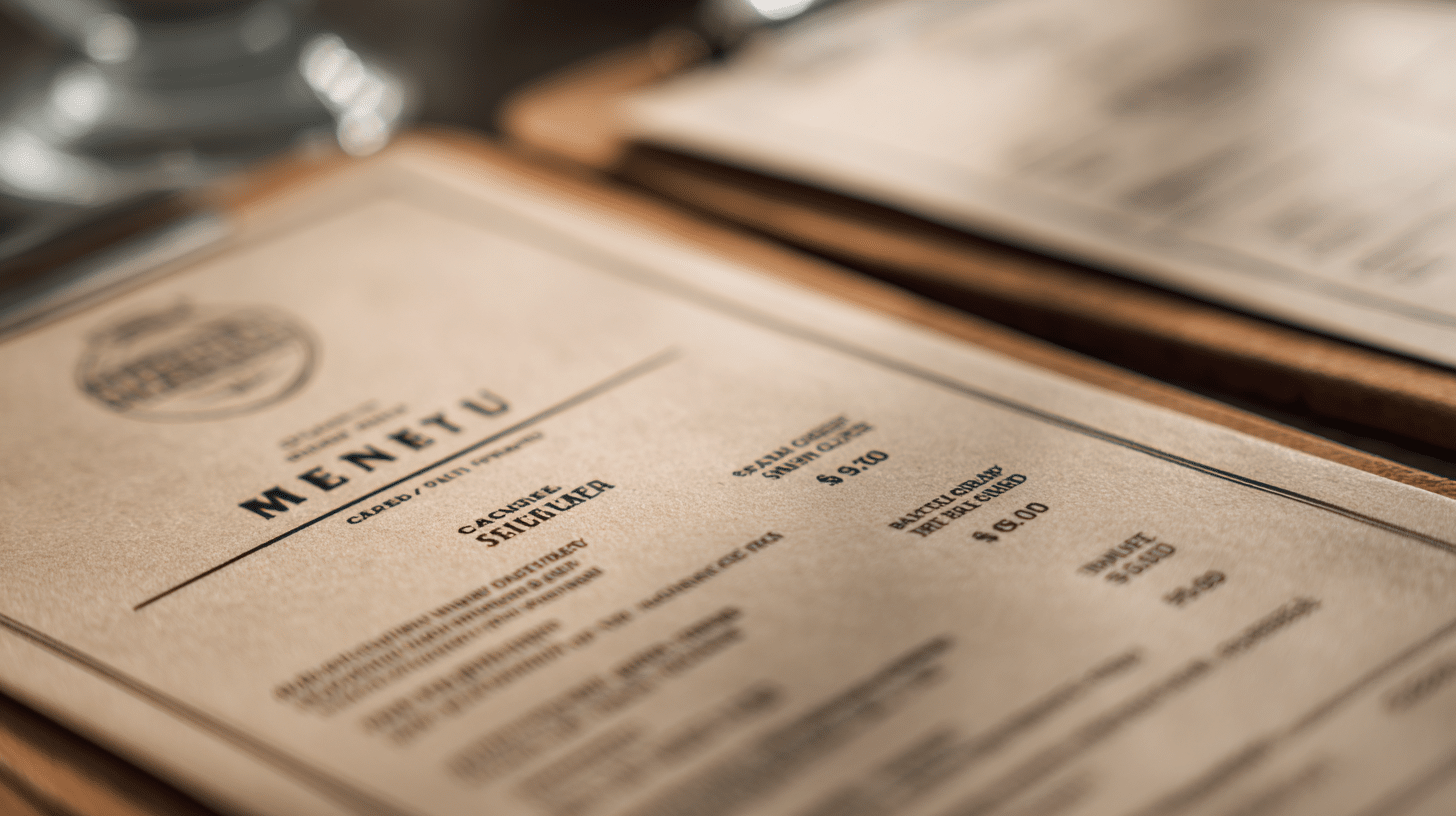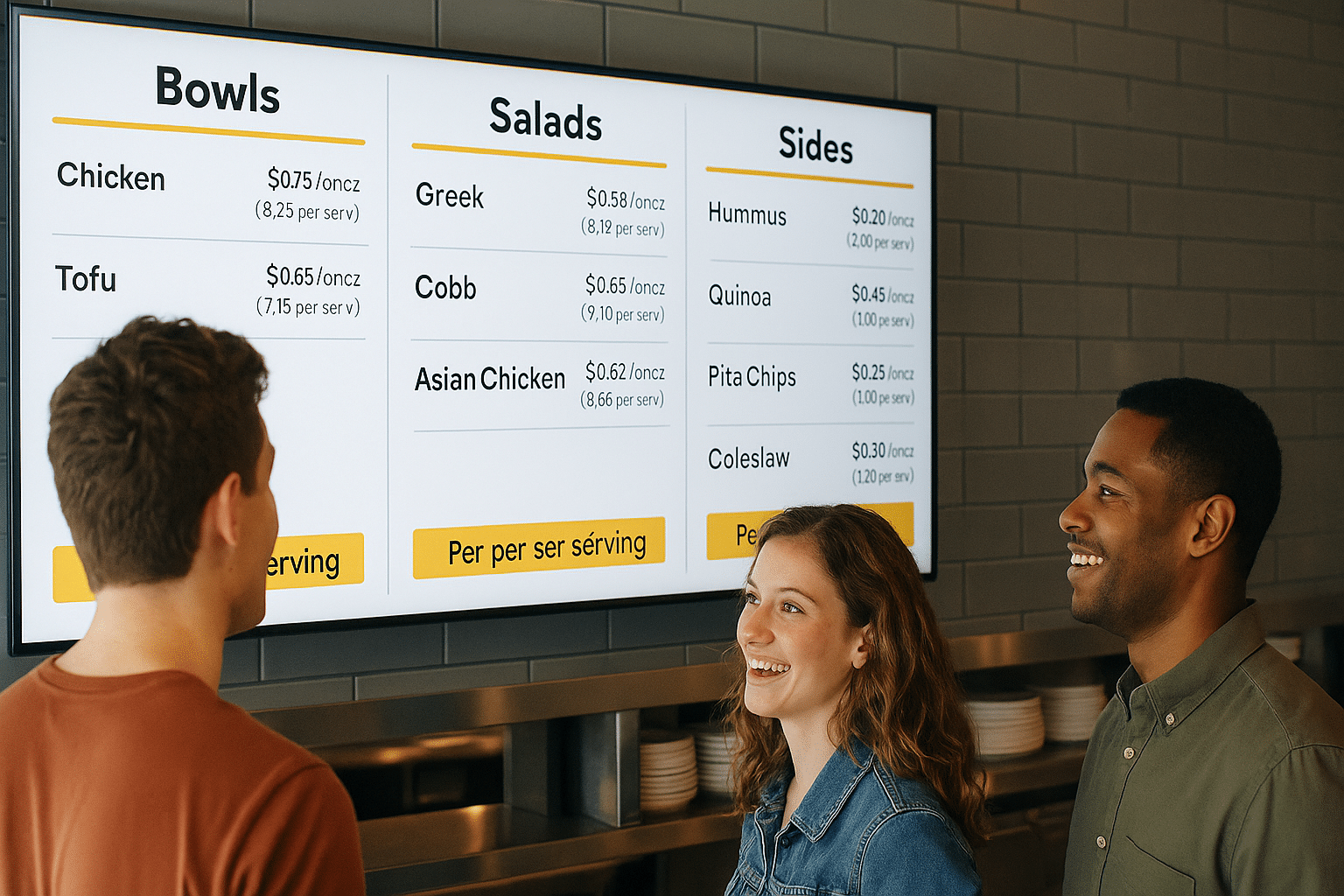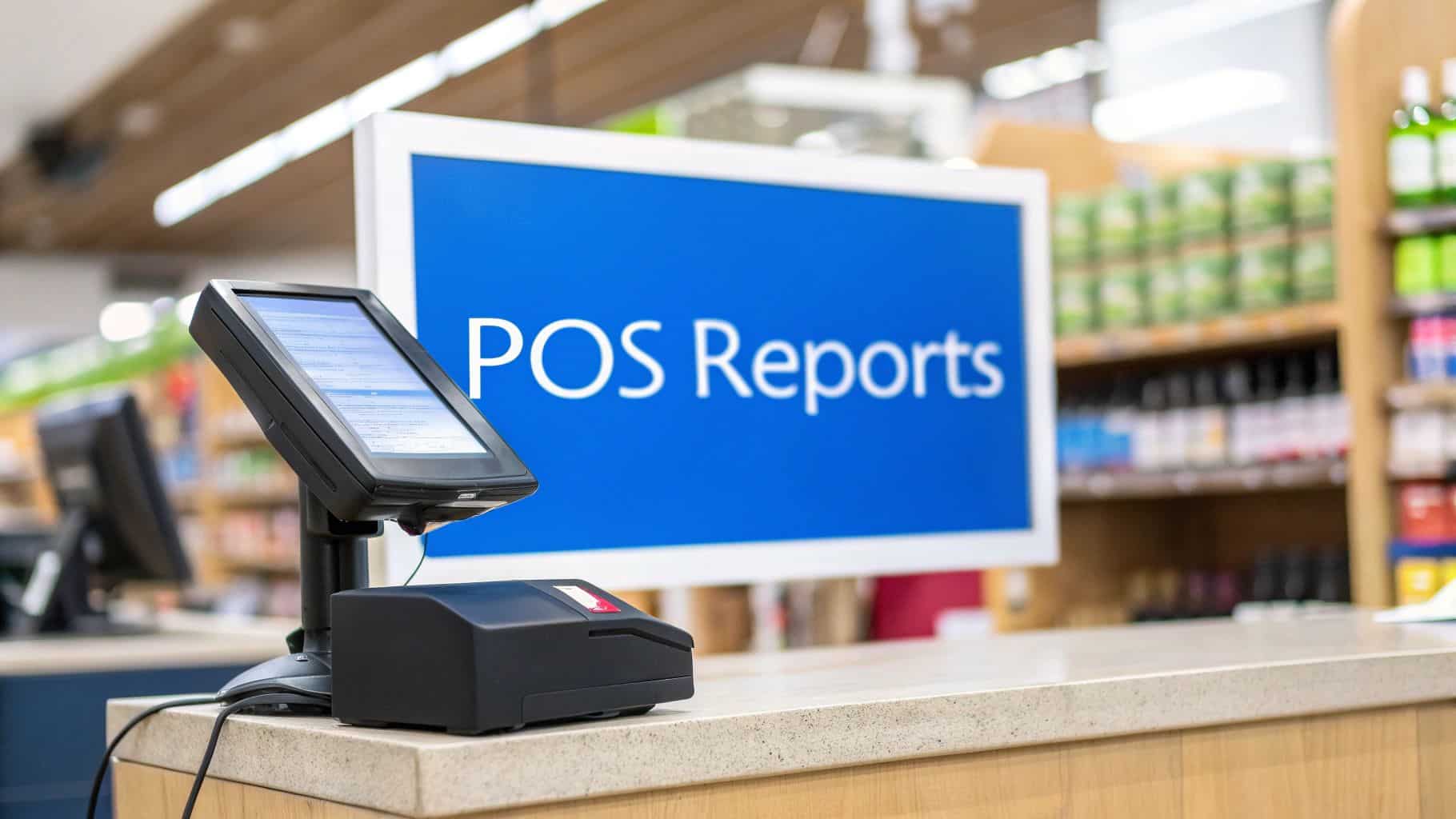Unit pricing menus have revolutionized the way restaurants, cafes, and food service businesses present their pricing. By clearly showing the price per ounce, cost per serving, or per-unit cost, these menus offer greater pricing transparency to consumers. This clarity empowers customers to make informed decisions, promoting fair pricing and menu clarity. Whether it’s a la carte pricing or bulk pricing, unit pricing menus ensure consistent pricing and help businesses optimize their menu offerings effectively. In this article, we’ll explore the ins and outs of unit pricing menus, how they improve value pricing, and why they matter for both consumers and businesses.
Table of Contents
- Understanding Unit Pricing Menus
- Benefits of Pricing Transparency in Menus
- Implementing Standardized Pricing and Pricing Labels
- Optimizing Menus for Value Pricing and Cost Efficiency
- Designing Consumer-Friendly Unit Pricing Menus
- About Biyo POS
- FAQ
Understanding Unit Pricing Menus
Unit pricing menus focus on showing the cost of menu items broken down into smaller, standardized units such as price per ounce or portion cost. This allows customers to compare prices across different items easily, even if the portion sizes vary. The core idea behind unit pricing menus is to promote pricing transparency by displaying itemized costs clearly, helping consumers understand exactly what they pay for each serving.
What Are Unit Pricing Menus?
Unit pricing menus are designed to present prices based on consistent measurement units such as ounces, grams, or servings, rather than just showing the total cost of an item. This approach helps customers evaluate the value of each menu item by understanding exactly what they pay for the amount they receive. For example, if a cafe offers coffee in 8-ounce and 12-ounce sizes, displaying a price per ounce next to each size enables customers to see which option gives them better value for money.
This system helps remove ambiguity when comparing items. Customers no longer have to guess which size is more cost-effective or feel uncertain about paying a seemingly higher price for a smaller portion. Instead, unit pricing menus clearly communicate the cost per standardized unit, enabling more informed choices. This transparency is particularly important in food service settings where portion sizes can vary greatly.
Restaurants often integrate unit pricing menus into their itemized pricing strategy to ensure consistent pricing logic across the menu. This strategy reduces customer confusion and improves satisfaction by making price comparison straightforward. It also promotes trust between businesses and customers by clearly showing what each item costs on a per-unit basis.
The Role of Price Per Ounce and Cost Per Serving
Price per ounce and cost per serving are two of the most common metrics used in unit pricing menus. These metrics provide customers with a tangible measurement to understand the value of what they are purchasing. Price per ounce is especially useful for liquids and bulk items, such as beverages or soups, where volume is a key factor in pricing.
For instance, imagine a smoothie bar that sells small (12 ounces) and large (20 ounces) smoothies. The small might cost $6, and the large $9. Without unit pricing, customers might assume the larger is a better deal. But by showing the price per ounce — $0.50 for the small and $0.45 for the large — the menu clarifies that the large offers better value. This empowers customers to make smart decisions based on actual cost efficiency rather than just total price.
Cost per serving, meanwhile, works well for solid foods or pre-portioned dishes. For example, a bakery selling cookies could list the price per cookie (serving), allowing customers to compare the cost of a single cookie versus buying in bulk. This detailed pricing breakdown helps consumers understand their spending and enhances perceived fairness in pricing.
Menu Pricing Models and Their Influence
Unit pricing menus exist within a broader context of menu pricing models that include a la carte pricing, combo pricing, and bulk pricing. Understanding how unit pricing complements these models is essential for maximizing its benefits.
A la carte pricing allows customers to pick individual items, each priced separately. This can sometimes lead to confusion, especially when portion sizes vary widely. However, by applying unit pricing, restaurants can provide clarity by showing cost per ounce or serving alongside each item, helping diners compare options on a like-for-like basis.
Bulk pricing offers discounts for purchasing larger quantities, such as a family-sized pizza or a multi-pack of drinks. Unit pricing menus help illustrate the savings by breaking down the cost per unit, making the discount transparent. Customers can see how buying in bulk reduces the price per ounce or serving, helping them make value-based decisions. By integrating unit pricing into these models, businesses improve menu clarity and encourage smarter buying habits.

Benefits of Pricing Transparency in Menus
Pricing transparency is a crucial factor in today’s customer-centric market. Unit pricing menus improve transparency by making itemized costs clear and consistent. This openness benefits both consumers, who gain clarity, and businesses, which build trust and improve customer satisfaction.
Enhancing Menu Clarity and Consumer Trust
Clear and consistent pricing on menus leads directly to enhanced customer trust. When customers can see exactly how much they pay for each ounce or serving, they feel reassured that they are not being overcharged or misled. This transparency fosters positive relationships between businesses and customers, which is essential for long-term loyalty.
Consider a scenario where a customer compares two coffee shops. One displays only the total price for each size, while the other shows a detailed price per ounce. The latter communicates openness and honesty, likely making it the preferred choice for savvy consumers who want to get the best value.
This clarity also reduces questions and disputes at the point of sale, making transactions smoother. Customers appreciate when menus speak plainly and provide straightforward information, which in turn encourages repeat visits and positive reviews.
Supporting Fair Pricing and Price Comparison
Unit pricing menus uphold fair pricing by standardizing how prices are displayed. Instead of just focusing on the total cost of items, customers can see the relationship between price and quantity. This transparency makes price comparisons easier and fairer, especially when items come in different sizes or formats.
For example, in a deli, a sandwich might be offered in regular and large sizes. By showing the price per serving or per ounce of filling, customers can compare these options clearly and choose based on the best value rather than just the lowest price. This helps prevent confusion and enhances the customer’s ability to make budget-friendly choices.
Businesses benefit as well because fair pricing reduces customer complaints and fosters a positive reputation. Clear price comparison promotes a healthy competitive environment where quality and value are balanced transparently.
Driving Menu Optimization Through Transparency
Beyond improving customer experience, pricing transparency through unit pricing helps businesses optimize their menus strategically. When managers understand the cost per unit and how customers perceive value, they can refine portion sizes, prices, and product offerings accordingly.
For example, if a particular item has a high cost per serving but low sales, a restaurant may choose to adjust the portion size or renegotiate supplier prices to improve margins. Conversely, items with low unit cost and high popularity could be promoted more heavily to increase profitability.
Transparent pricing data also helps with inventory management by aligning ingredient purchases with portion control. This reduces waste and improves cost efficiency across the entire operation, which is a critical benefit in the food service industry.
Implementing Standardized Pricing and Pricing Labels
To fully realize the benefits of unit pricing menus, businesses need to implement standardized pricing and use clear pricing labels. This ensures consistency across all items and channels, providing customers with easy-to-understand, accurate information.
Creating Consistent Pricing for All Menu Items
Standardized pricing means applying the same unit cost principles to all menu items, regardless of category. This consistency helps customers navigate the menu with confidence, knowing that every price reflects a clear unit cost.
For example, a restaurant could use price per ounce for beverages, price per serving for entrees, and price per piece for appetizers or desserts. By maintaining consistent units within these categories, the menu avoids confusion and makes comparison straightforward.
Consistency also benefits staff by simplifying training and reducing mistakes during ordering and billing. It streamlines communication both internally and with customers, resulting in a smoother dining experience.
Using Pricing Labels for Clear Cost Display
Pricing labels are essential tools for communicating unit prices effectively. These labels can be printed on menus, displayed digitally, or even used on physical signage for grab-and-go items.
Clear labels such as “$0.50 per ounce” or “$2 per serving” instantly inform customers of the pricing structure. Including these labels next to each item or category helps reduce confusion and makes the menu more approachable.
For instance, a cafe that offers freshly brewed coffee can include pricing labels that indicate the price per ounce, making it easier for customers to understand how much their drink costs relative to its size. Using digital tools like Biyo POS allows businesses to update these labels quickly and keep pricing consistent across platforms.
Addressing Challenges in Pricing Transparency
Despite its many advantages, implementing unit pricing can be challenging. One common difficulty is determining the appropriate unit of measurement for all menu items. While ounces work well for liquids, solid foods may require different metrics like servings or pieces, which can be less precise.
Additionally, presenting detailed pricing without cluttering the menu requires careful design. Overloading customers with numbers may overwhelm them rather than help them. Businesses must find a balance between transparency and simplicity to maintain readability.
Staff training is also critical. Employees should be knowledgeable about the pricing model so they can confidently explain it to customers and handle any questions. Investing in technology, such as Biyo POS, can ease these challenges by automating unit price calculations and label updates.
Optimizing Menus for Value Pricing and Cost Efficiency
Unit pricing menus are powerful tools for optimizing value pricing and improving cost efficiency. They help both customers and businesses understand the real cost of menu items, driving smarter purchasing and pricing decisions.
Using Unit Pricing to Highlight Value
Value pricing means offering prices that customers perceive as fair relative to the quality and quantity they receive. Unit pricing emphasizes this by revealing the exact price per unit, making it easier for customers to see where they get the most bang for their buck.
For example, a juice bar might offer a 16-ounce juice for $8 and a 24-ounce juice for $10. While the total price is higher for the larger size, the unit price tells the full story: $0.50 per ounce for the small and about $0.42 per ounce for the large. Customers who see this are more likely to purchase the larger size, feeling they are getting better value.
By clearly communicating value through unit pricing, businesses can increase average order sizes and customer satisfaction simultaneously.
Improving Cost Efficiency with Pricing Transparency
Transparent unit pricing also helps businesses control costs more effectively. By linking menu prices to portion sizes and ingredient costs, managers can identify inefficiencies and make targeted adjustments.
For instance, if a dish’s cost per serving is higher than expected, the kitchen might tweak the recipe or portion size to improve margins without compromising quality. Alternatively, the business might adjust prices to better reflect ingredient costs, ensuring profitability.
Such insights can extend to bulk pricing strategies. Clearly displaying how unit costs decrease with larger purchases encourages customers to buy more while helping businesses manage inventory better and reduce waste.
Leveraging Technology for Menu Optimization
Technology plays a vital role in implementing and maintaining effective unit pricing menus. POS systems like Biyo POS integrate inventory and pricing data, automating price per unit calculations and making it simple to update menus.
Biyo POS allows restaurants to maintain consistent pricing labels and clear cost displays across both physical and digital menus. This reduces errors and saves time, allowing staff to focus on delivering excellent customer service.
Moreover, using such technology facilitates real-time pricing adjustments in response to ingredient cost fluctuations or promotional campaigns, keeping menus both competitive and profitable.
Designing Consumer-Friendly Unit Pricing Menus
Effective menu design is critical to ensuring that unit pricing is understood and appreciated by customers. Menus must be visually clear, easy to read, and logically organized to maximize the benefits of pricing transparency.
Ensuring Clear and Simple Price Breakdown
Menus should present unit pricing in a straightforward way that customers can understand at a glance. Using simple language such as “Price per ounce” or “Cost per serving” helps avoid confusion. Visual aids like columns or icons can emphasize these prices, making it easier for customers to find the information.
For example, a smoothie menu might show the total price alongside a smaller font or separate column listing the price per ounce. This layout helps customers quickly grasp the value without feeling overwhelmed by numbers.
Clarity in pricing breakdown encourages confidence and speeds up ordering decisions, improving the overall dining experience.
Balancing Detail and Readability
While detailed pricing is important, it should never come at the expense of readability. Menus must balance providing enough information with keeping the layout clean and approachable.
Grouping items by category and consistently applying unit pricing within each group can simplify the menu. For instance, grouping all beverages together and listing their price per ounce allows customers to compare easily, while food items might be grouped by portion size with price per serving.
Keeping menus visually organized reduces decision fatigue and helps customers focus on choosing their favorite items rather than decoding pricing.
Using Unit Pricing to Build Brand Trust
Transparent and consumer-friendly pricing reflects a brand’s commitment to fairness and honesty. Customers notice when businesses take care to communicate pricing clearly, which builds goodwill and trust.
Over time, unit pricing menus can become part of a brand’s identity, signaling a customer-first approach. This reputation encourages repeat visits and positive recommendations, essential in competitive food service markets.
By consistently delivering transparent, fair pricing through well-designed menus, businesses create lasting relationships with their customers that go beyond a single meal.
About Biyo POS
Biyo POS offers a powerful point-of-sale system designed to support modern businesses with features tailored for pricing transparency and menu optimization. With Biyo POS, restaurants and cafes can effortlessly implement unit pricing menus that highlight price per ounce, cost per serving, and other per-unit cost metrics.
The platform enables consistent pricing labels, clear cost displays, and easy menu updates—all essential for creating consumer-friendly and fair pricing models. By integrating with inventory and sales data, Biyo POS helps businesses improve cost efficiency and deliver an exceptional customer experience. Choose Biyo POS to streamline your menu pricing and boost transparency today.
FAQ
What are unit pricing menus?
Unit pricing menus display prices based on standardized units such as price per ounce or cost per serving. This approach improves pricing transparency and helps customers compare the value of different menu items easily.
How does unit pricing benefit consumers?
Consumers benefit by gaining clear insights into the true cost of items, enabling informed choices. It promotes fair pricing and reduces confusion over portion sizes and total prices.
Can unit pricing menus improve business profitability?
Yes. Unit pricing helps businesses optimize menus, manage costs efficiently, and set prices that reflect actual value. This leads to better inventory control and stronger profit margins.
Is unit pricing applicable to all types of menus?
While unit pricing works best with portion-based items like beverages and snacks, it can be adapted to various menu types. The key is to choose appropriate units and communicate prices clearly.
How can technology help implement unit pricing menus?
POS systems like Biyo POS automate price per unit calculations, maintain consistent pricing labels, and simplify menu updates. This technology streamlines the transition to unit pricing and supports pricing transparency.




